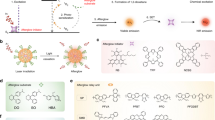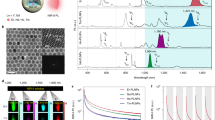Abstract
Afterglow optical agents, which emit light long after cessation of excitation, hold promise for ultrasensitive in vivo imaging because they eliminate tissue autofluorescence. However, afterglow imaging has been limited by its reliance on inorganic nanoparticles with relatively low brightness and short-near-infrared (NIR) emission. Here we present semiconducting polymer nanoparticles (SPNs) <40 nm in diameter that store photon energy via chemical defects and emit long-NIR afterglow luminescence at 780 nm with a half-life of ∼6 min. In vivo, the afterglow intensity of SPNs is more than 100-fold brighter than that of inorganic afterglow agents, and the signal is detectable through the body of a live mouse. High-contrast lymph node and tumor imaging in living mice is demonstrated with a signal-to-background ratio up to 127-times higher than that obtained by NIR fluorescence imaging. Moreover, we developed an afterglow probe, activated only in the presence of biothiols, for early detection of drug-induced hepatotoxicity in living mice.
This is a preview of subscription content, access via your institution
Access options
Access Nature and 54 other Nature Portfolio journals
Get Nature+, our best-value online-access subscription
$29.99 / 30 days
cancel any time
Subscribe to this journal
Receive 12 print issues and online access
$209.00 per year
only $17.42 per issue
Buy this article
- Purchase on Springer Link
- Instant access to full article PDF
Prices may be subject to local taxes which are calculated during checkout






Similar content being viewed by others
References
Ntziachristos, V., Ripoll, J., Wang, L.V. & Weissleder, R. Looking and listening to light: the evolution of whole-body photonic imaging. Nat. Biotechnol. 23, 313–320 (2005).
Smith, A.M., Mancini, M.C. & Nie, S. Bioimaging: second window for in vivo imaging. Nat. Nanotechnol. 4, 710–711 (2009).
Chu, J. et al. A bright cyan-excitable orange fluorescent protein facilitates dual-emission microscopy and enhances bioluminescence imaging in vivo. Nat. Biotechnol. 34, 760–767 (2016).
Thorek, D.L., Ogirala, A., Beattie, B.J. & Grimm, J. Quantitative imaging of disease signatures through radioactive decay signal conversion. Nat. Med. 19, 1345–1350 (2013).
So, M.K., Xu, C., Loening, A.M., Gambhir, S.S. & Rao, J. Self-illuminating quantum dot conjugates for in vivo imaging. Nat. Biotechnol. 24, 339–343 (2006).
Liu, H. et al. Intraoperative imaging of tumors using Cerenkov luminescence endoscopy: a feasibility experimental study. J. Nucl. Med. 53, 1579–1584 (2012).
le Masne de Chermont, Q. et al. Nanoprobes with near-infrared persistent luminescence for in vivo imaging. Proc. Natl. Acad. Sci. USA 104, 9266–9271 (2007).
Maldiney, T. et al. Controlling electron trap depth to enhance optical properties of persistent luminescence nanoparticles for in vivo imaging. J. Am. Chem. Soc. 133, 11810–11815 (2011).
Maldiney, T. et al. The in vivo activation of persistent nanophosphors for optical imaging of vascularization, tumours and grafted cells. Nat. Mater. 13, 418–426 (2014).
Li, Z. et al. Direct aqueous-phase synthesis of sub-10 nm “luminous pearls” with enhanced in vivo renewable near-infrared persistent luminescence. J. Am. Chem. Soc. 137, 5304–5307 (2015).
Lécuyer, T. et al. Chemically engineered persistent luminescence nanoprobes for bioimaging. Theranostics 6, 2488–2524 (2016).
Maldiney, T. et al. In vivo optical imaging with rare earth doped Ca2Si5N8 persistent luminescence nanoparticles. Opt. Mater. Express 2, 261–268 (2012).
Abdukayum, A., Chen, J.T., Zhao, Q. & Yan, X.P. Functional near infrared-emitting Cr3+/Pr3+ co-doped zinc gallogermanate persistent luminescent nanoparticles with superlong afterglow for in vivo targeted bioimaging. J. Am. Chem. Soc. 135, 14125–14133 (2013).
Liu, F. et al. Photostimulated near-infrared persistent luminescence as a new optical read-out from Cr3+-doped LiGa5O8 . Sci. Rep. 3, 1554 (2013).
Maldiney, T. et al. In vivo imaging with persistent luminescence silicate-based nanoparticles. Opt. Mater. 35, 1852–1858 (2013).
Sharma, S.K. et al. Persistent luminescence of AB2O4:Cr3+ (A = Zn, Mg, B = Ga, Al) spinels: new biomarkers for in vivo imaging. Opt. Mater. 36, 1901–1906 (2014).
Shi, J. et al. Multifunctional near infrared-emitting long-persistence luminescent nanoprobes for drug delivery and targeted tumor imaging. Biomaterials 37, 260–270 (2015).
Toppari, J. et al. Male reproductive health and environmental xenoestrogens. Environ. Health Perspect. 104 (Suppl. 4), 741–803 (1996).
Maldiney, T. et al. In vitro targeting of avidin-expressing glioma cells with biotinylated persistent luminescence nanoparticles. Bioconjug. Chem. 23, 472–478 (2012).
Maldiney, T. et al. Synthesis and functionalization of persistent luminescence nanoparticles with small molecules and evaluation of their targeting ability. Int. J. Pharm. 423, 102–107 (2012).
Kobayashi, H. & Choyke, P.L. Target-cancer-cell-specific activatable fluorescence imaging probes: rational design and in vivo applications. Acc. Chem. Res. 44, 83–90 (2011).
Lovell, J.F., Liu, T.W., Chen, J. & Zheng, G. Activatable photosensitizers for imaging and therapy. Chem. Rev. 110, 2839–2857 (2010).
Chen, L.J. et al. Activatable multifunctional persistent luminescence nanoparticle/copper sulfide nanoprobe for in vivo luminescence imaging-guided photothermal therapy. ACS Appl. Mater. Interfaces 8, 32667–32674 (2016).
Feng, L. et al. Conjugated polymer nanoparticles: preparation, properties, functionalization and biological applications. Chem. Soc. Rev. 42, 6620–6633 (2013).
Wu, C. & Chiu, D.T. Highly fluorescent semiconducting polymer dots for biology and medicine. Angew. Chem. Int. Ed. 52, 3086–3109 (2013).
Qian, C. et al. Light-activated hypoxia-responsive nanocarriers for enhanced anticancer therapy. Adv. Mater. 28, 3313–3320 (2016).
Zhen, X. et al. Intraparticle energy level alignment of semiconducting polymer nanoparticles to amplify chemiluminescence for ultrasensitive in vivo imaging of reactive oxygen species. ACS Nano 10, 6400–6409 (2016).
Pu, K. et al. Semiconducting polymer nanoparticles as photoacoustic molecular imaging probes in living mice. Nat. Nanotechnol. 9, 233–239 (2014).
Hong, G. et al. Ultrafast fluorescence imaging in vivo with conjugated polymer fluorophores in the second near-infrared window. Nat. Commun. 5, 4206 (2014).
Lyu, Y., Xie, C., Chechetka, S.A., Miyako, E. & Pu, K. Semiconducting polymer nanobioconjugates for targeted photothermal activation of neurons. J. Am. Chem. Soc. 138, 9049–9052 (2016).
Ghezzi, D. et al. A hybrid bioorganic interface for neuronal photoactivation. Nat. Commun. 2, 166 (2011).
Palner, M., Pu, K., Shao, S. & Rao, J. Semiconducting polymer nanoparticles with persistent near-infrared luminescence for in vivo optical imaging. Angew. Chem. Int. Ed. 54, 11477–11480 (2015).
Scurlock, R.D., Wang, B.J., Ogilby, P.R., Sheats, J.R. & Clough, R.L. Singlet oxygen as a reactive intermediate in the photodegradation of an electroluminescent polymer. J. Am. Chem. Soc. 117, 10194–10202 (1995).
Kim, S. et al. Near-infrared fluorescent type II quantum dots for sentinel lymph node mapping. Nat. Biotechnol. 22, 93–97 (2004).
Nasr, A., Lauterio, T.J. & Davis, M.W. Unapproved drugs in the United States and the Food and Drug Administration. Adv. Ther. 28, 842–856 (2011).
Kola, I. & Landis, J. Can the pharmaceutical industry reduce attrition rates? Nat. Rev. Drug Discov. 3, 711–716 (2004).
Willmann, J.K., van Bruggen, N., Dinkelborg, L.M. & Gambhir, S.S. Molecular imaging in drug development. Nat. Rev. Drug Discov. 7, 591–607 (2008).
Pessayre, D., Mansouri, A., Berson, A. & Fromenty, B. Mitochondrial involvement in drug-induced liver injury. Handb. Exp. Pharmacol. 311–365 (2010).
Dodeigne, C., Thunus, L. & Lejeune, R. Chemiluminescence as diagnostic tool. A review. Talanta 51, 415–439 (2000).
Maldiney, T. et al. Effect of core diameter, surface coating, and PEG chain length on the biodistribution of persistent luminescence nanoparticles in mice. ACS Nano 5, 854–862 (2011).
Shuhendler, A.J., Pu, K., Cui, L., Uetrecht, J.P. & Rao, J. Real-time imaging of oxidative and nitrosative stress in the liver of live animals for drug-toxicity testing. Nat. Biotechnol. 32, 373–380 (2014).
Acknowledgements
K.P. thanks Nanyang Technological University (Start-Up grant: NTUSUG: M4081627.120) and Singapore Ministry of Education (Academic Research Fund Tier 1 RG133/15 M4011559 and Tier 2 MOE2016-T2-1-098) for financial support. H.D. thanks Singapore Ministry of Education (Academic Research Fund Tier 2 MOE2015-T2-1-112 and Tier 3 MOE2013-T3-1-002) for financial support. J.V.J. thanks NIH HL 137187 and NIH HL 117048 grants for financial support.
Author information
Authors and Affiliations
Contributions
K.P. conceived and designed the study. Q.M. performed the nanoparticle synthesis and in vitro experiments. Q.M., C.X., X.Z. and Y. L. performed the in vivo experiments. K.P., Q.M., H.D., X. L. and J.V.J. contributed to the analysis and interpretation of results and preparation of the manuscript draft. K.P., Q.M., H.D., X.L., J.V.J. and all other authors contributed to the writing of this paper.
Corresponding author
Ethics declarations
Competing interests
The authors declare no competing financial interests.
Supplementary information
Supplementary Text and Figures
Supplementary Figures 1–40 and Supplementary Table 1 (PDF 28288 kb)
Rights and permissions
About this article
Cite this article
Miao, Q., Xie, C., Zhen, X. et al. Molecular afterglow imaging with bright, biodegradable polymer nanoparticles. Nat Biotechnol 35, 1102–1110 (2017). https://doi.org/10.1038/nbt.3987
Received:
Accepted:
Published:
Issue Date:
DOI: https://doi.org/10.1038/nbt.3987
This article is cited by
-
In vivo ultrasound-induced luminescence molecular imaging
Nature Photonics (2024)
-
Acidity-activatable upconversion afterglow luminescence cocktail nanoparticles for ultrasensitive in vivo imaging
Nature Communications (2024)
-
Noninvasive in vivo microscopy of single neutrophils in the mouse brain via NIR-II fluorescent nanomaterials
Nature Protocols (2024)
-
Preparation of AIEgen-based near-infrared afterglow luminescence nanoprobes for tumor imaging and image-guided tumor resection
Nature Protocols (2024)
-
Illuminating cancer with sonoafterglow
Nature Photonics (2024)



